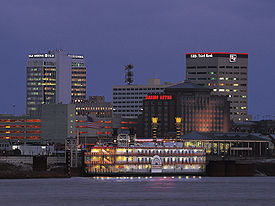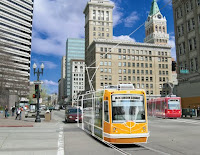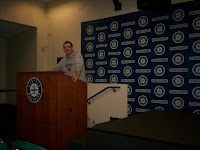
Although I'm not a big follower of artists, one artist that has stuck out to me across the United States and elsewhere has been Robert Indiana.
Per Wikipedia...
Robert Indiana was born Robert Clark in New Castle, Indiana. His family relocated to Indianapolis, where he graduated from Arsenal Technical High School. He moved to New York City in 1954 and joined the pop art movement, using distinctive imagery drawing on commercial art approaches blended with existentialism, that gradually moved toward what Indiana calls "sculptural poems".
Indiana's work often consists of bold, simple, iconic images, especially numbers and short words like EAT, HUG, and, his best known example, LOVE.
In 2008, Indiana created an image similar to his iconic LOVE (letters stacked two to a line, the letter "o" tilted on its side), but this time showcasing the word "HOPE," and donated all proceeds from the sale of reproductions of his image to Democrat Barack Obama's presidential campaign, Raising in excess of $1,000,000. A stainless steel sculpture of HOPE was unveiled outside Denver's Pepsi Center during the 2008 Democratic National Convention. The Obama campaign sold T-shirts, pins, bumper stickers, posters, pins and other items adorned with HOPE. Editions of the sculpture have been released and sold internationally and the artist himself has called HOPE "Love's close relative".
Other well-known works by Indiana including: his painting the unique basketball court formerly used by the Milwaukee Bucks in that city's U.S. Cellular Arena, with a large M shape taking up each half of the court; his sculpture in the lobby of Taipei 101, called 1-0 (2002, aluminum), uses multicoloured numbers to suggest the conduct of world trade and the patterns of human life; and the works he created in the aftermath of the September 11, 2001 attacks and exhibited in New York in 2004 called the Peace Paintings.
http://en.wikipedia.org/wiki/Robert_Indiana
For those who haven't been to Philadelphia, Indiana's LOVE Sculpture is quite impressive as well as a powerful message. It has turned an ordinary park into a park that tourists visit frequently at Philadelphia's John F. Kennedy Plaza- LOVE Park. I was so impressed with the sculpture that I bought a pencil sharpener in Philadelphia that has the LOVE Sculpture on it.
Indiana has spread his design not only to Philadelphia but to other cities and countries as well. Wikipedia describes the design and idea best...
Love is a sculpture by American artist Robert Indiana. It consists of the letters LO (with the O canted sideways) over the letters VE. The image was originally designed as a Christmas card for the Museum of Modern Art in 1964, and first exhibited as a sculpture in New York City in 1970. This original sculpture is made of COR-TEN steel and has been on exhibit at the Indianapolis Museum of Art since 1975. The LOVE design has been reproduced in a variety of formats. Likewise, the sculpture has been recreated in multiple versions and a variety of colors, and is now on display around the world.
While it was first made in English, versions of the sculpture exist in Hebrew, Chinese, Italian and Spanish.
http://en.wikipedia.org/wiki/Love_(sculpture)
The LOVE Sculpture is in many locations now...
Versions of Love in the United States
Indianapolis Museum of Art, Indianapolis, Indiana
Sixth Avenue in New York City
E.W. Fairchild-Martindale Library, Lehigh University Asa Packer Campus
Pratt Institute campus in Brooklyn, New York
Scottsdale's Civic Center
John F. Kennedy Plaza "LOVE Park" in Philadelphia
New Orleans Museum of Art's sculpture garden
Old School Square in Delray Beach, Florida
Middlebury College campus, Vermont
University of Pennsylvania campus, Philadelphia
Museum of Art at Brigham Young University, Utah
Ursinus College campus in Collegeville, Pennsylvania
Pool area of the Red Rock Resort Spa and Casino in Las Vegas
Wichita State University campus in Wichita, Kansas
City Park in New Orleans, Louisiana
Winslow-Holbrook Memorial Park Rockland, Maine
Versions of Love outside of the United States
Shinjuku I-LAND Tower in Nishi-Shinjuku office district in Tokyo, Japan
Taipei 101 in Taipei, Taiwan (also displays Indiana's 1-0)
Orchard Road in Singapore
Plaza del Sagrado Corazón in Bilbao, Basque Country Spain
Outside 1445 West Georgia Street in Vancouver, Canada
Praça do Rossio in Lisbon, Portugal
CentralWorld in Bangkok, Thailand
Zendai Museum of Modern Art in Shanghai, China
World Trade Center, Hong Kong, China
Chatsworth in Derbyshire, UK, as part of the Sotheby's Beyond Limits exhibition, 2008
Love Park in Bishkek, Kyrgyzstan, since July 2009
Old Port in Montreal, Canada
Camlica in Istanbul, Turkey
With all of these cities and countries adopting Indiana's artwork, shouldn't Evansville have something to recognize the native Hoosier? It would only seem logical. Furthermore, Evansville could use Indiana both for a LOVE Sculpture as well as a "Big E." So, where would I put Indiana's work?
For the LOVE Sculpture, there are two perfect locations for this. The first and preferred location is Haynie's Corner. What better place to put a LOVE Sculpture than the historic arts district? The second location is the Evansville Museum. Like the art distric, the Evansville Museum has several pieces of great artwork. Also, the Evansville Museum is on the riverfront which is a great place to display this sculpture.
If I had to choose, I would place the LOVE sculpture in Haynie's Coroner and then request Indiana design another sculpture for the riverfront museum. Again, if I had to choose I would say that a "Big E," would sum up Evansville best but Indiana likes building sculptures with 3-4 letters in them to get a better design. So what 3-4 letters could we do to sum up Evansville?
- EVV- with a Big E
- EVIN- with a Big E
- EVAN- with a Big E
- EVVE- with a Big E
I think any one of those 4 designs would maintain the "Big E" message as well as create a better design where we could slant the 2nd and 3rd letters to make it look creative. I believe this design would give Evansville another great sculpture/monument for tourists to visit, residents to gather around, and the museum to market.
Lastly, I wouldn't just stop there with Indiana's work. Like the historic U.S Cellular Arena used Indiana's M shape design on its court back when it was known as the MECCA ( http://en.wikipedia.org/wiki/U.S._Cellular_Arena ) and the Milwaukee Bucks played there, I would paint the Evansville Ace's new basketball court at the new Evansville Arena with a "Big E," on each side of the court.

( Old Court at the MECCA; All we have to do is flip the M to an E, change the colors, and add the court markings)
Afterall, the new arena sits on the land formely occupied by the Executive Inn which was known as "The Big E."

Overall, I think working with Robert Indiana is a win-win for both Mr. Indiana as well as Evansville. We would establish our "Big E," image, join the famous list of area's with Indiana's LOVE Sculpture, attract tourists to a downtown sculpture on the riverfront, and design a creative image for the Evansville Ace's basketball court.
We have to bring Robert Indiana to Evansville, Indiana!












